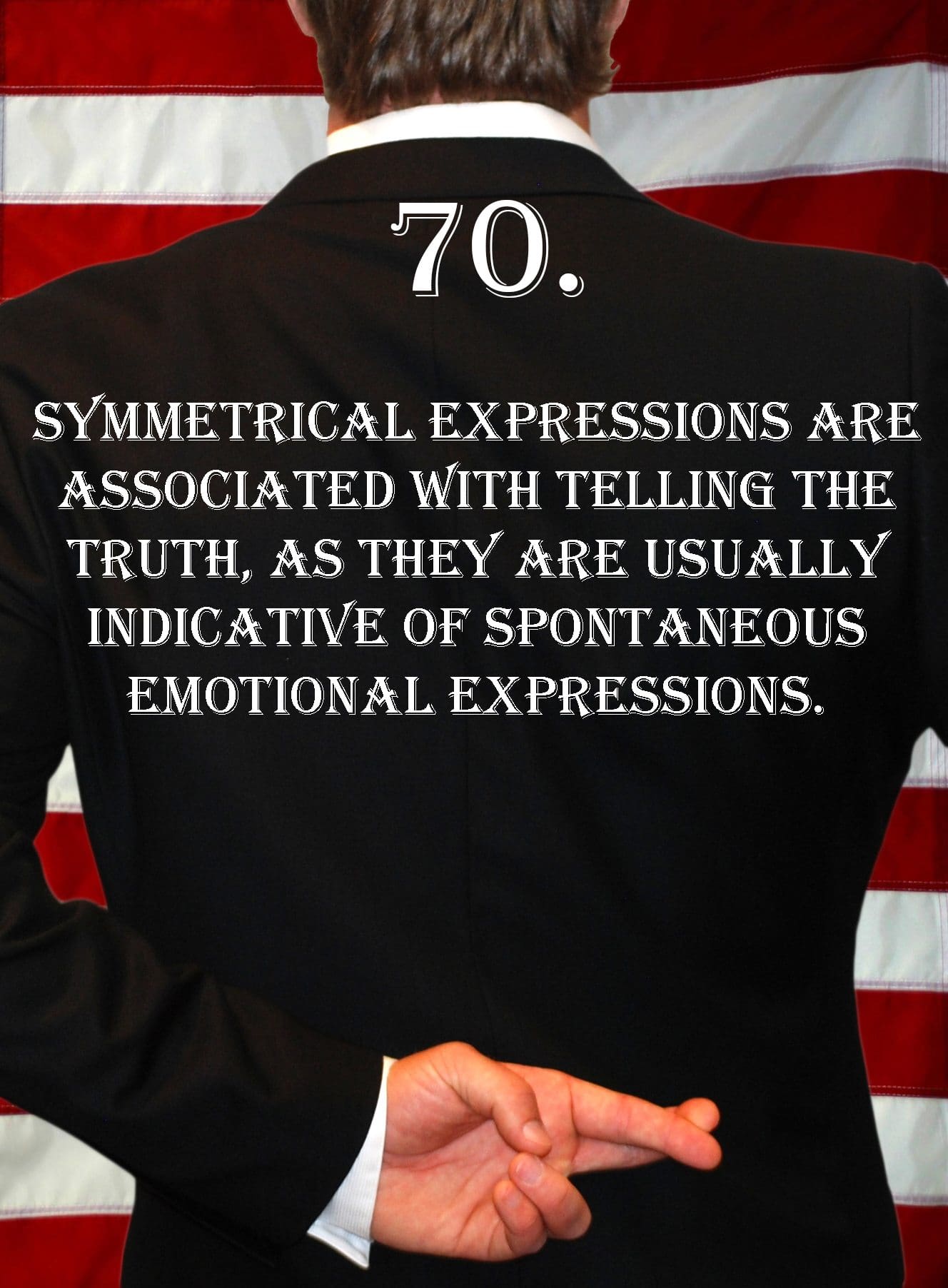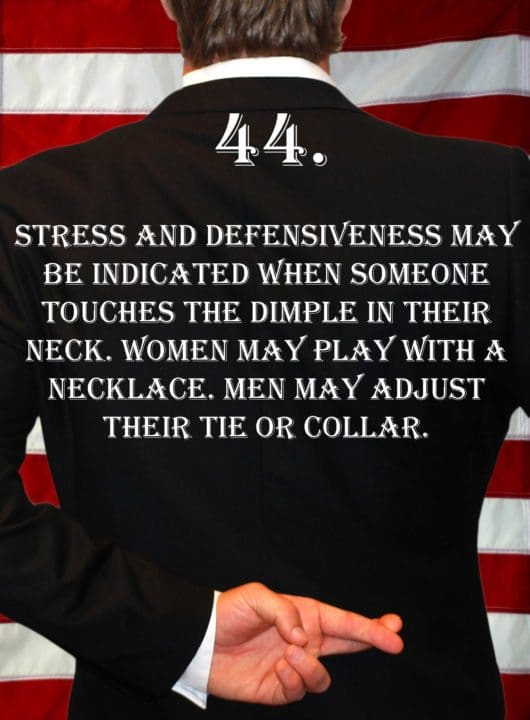
Deception Tip 70:
Symmetrical expressions are associated with telling the truth, as they are usually indicative of spontaneous emotional expressions.
Listen To The Podcast!
E70 – Symmetrical And Spontaneous – Deception Tips Podcast – Click Here To Subscribe
Podcast Transcript
Hello and welcome to the deception tips podcast where you will learn amazing cues to detect deceit that will help you read people like never before. I’m your host Spencer Coffman, let’s get started.
Welcome to episode 70 of the Deception Tips podcast. Thank you for listening to this podcast, I encourage you to check out the free deception tips blog, and also take a look at the deception tips website at deceptiontips.com.
I’ve got all the videos there, those are free for you to watch as well and all the podcasts are there. In addition, there are transcripts of all of these podcasts and transcripts of all of the videos.
Therefore, if you’re more of a reader or you need to quickly find something and you want to do a command or Ctrl F on the screen to type it out and see where it was and then read about it a little bit or skip to that place in the video or the podcast, check that out, that is made available for free for you guys.
I really hope that by now you have read either The Deception Tips book, The Deception Tips Revised and Expanded book, or A Guide to Deception, so I hope that you’ve taken the time to check out those and read them as well. I’ve also got them available in audiobook form as well if they’re not available now they’re coming soon, so stay tuned for that as well.
Thanks again, I hope that you’re going to take advantage of those additional resources that are available for you to use. Also, share it with your friends because you want your friends to know the truth as well. Last time, we spoke of a deception tip that was related to speaking, we talked about how when people lie, they are under tremendous amounts of stress and tension.
There’s a lot of pressure going on there, there’s a lot of anxiety, they are on the edge of their seat, probably literally and figuratively, they are anxious. Therefore, when you become silent when they’re talking to you, when you stop talking, their comfort level is going to go from bad, because they’re already uncomfortable, to worse, they’re going to be very uncomfortable.
This is important because they may continue to speak in order to fill that gap so that they will be convinced that you are believing their lie. We talked about this last week and we also spoke of it a long time ago, back in episode 13.
If you haven’t listened to that or if you don’t remember it, then I encourage you to go back, listen to it, watch the video, read the blog posts, whatever you need to do to refresh your memory so that you will know exactly what we’re talking about in that instance.
Today, we’ve got a different tip, of course, this one we’ve also talked about several times before, however, today we’re going to give you a little bit more detail on it. We’re going to dive into the review of all of the past tips because you need to keep this information in your mind.
You need to constantly be reviewing it, you need to constantly be reminded of it and you need to always be looking for it when you’re speaking and when you’re interacting with other people because it’s very, very important.
Otherwise, you wouldn’t still be listening to this podcast, you know it’s important, therefore, we’re going to dive into it here today. Here it is, deception tip 70. Symmetrical expressions are associated with telling the truth as they are usually indicative of spontaneous, emotional expressions. Here it is again, deception tip 70. Symmetrical expressions are associated with telling the truth as they are usually indicative of spontaneous, emotional expressions.
So, there were a lot of big words there, symmetrical, expressions, associated, indicative, spontaneous, emotional, expressions, a lot of three-syllable words. For a lot of people, that would be too much to handle and it would be very confusing.
However, for you guys, I know it’s not. If it is, that’s why I’ve got it in text format, it’s in the videos, it’s all over the place, so you can see it multiple times in multiple different varieties, you can see it there and understand it, it can be visual in front of you.
So, we’re going to break it down to make it much easier for you to understand really quickly here, symmetrical expressions, which means they happen the same on both sides of the face and body. They are associated with truthfulness because they mean that something has happened spontaneously. So, like on the spot, it’s happened, boom, there it is, it’s real, it’s a genuine emotional expression.
As I said, we’ve spoken about this many times before, not about this in particular but about symmetricality, asymmetricality, and spontaneous and simultaneous gestures and expressions. So, we’re going to go back to the beginning, and I’ll go from the front, in the beginning up until now and all the times that we’ve had an episode dedicated in or around this topic.
So, starting back at episode number 12, we talked of simultaneous gestures, which means gestures should be simultaneous or congruent with the speech. If you remember that would be pounding on the table and saying the word at the same time, not one or another or one after the other, so go ahead and listen to that one again, review it.
In episode 14, we talked about symmetrical expressions, so that’s very similar to today’s episode when we spoke of how symmetrical means truth, expressions need to be the same on both sides of the face. Then episode 16, symmetrical gestures, that was how gestures, bodily gestures, whether it’s hand movements, feet, whatever the case, should be the same on both sides of the body.
If you gesture with one hand you should gesture with the other. You can do them asymmetrically and that’s not what we’re talking about, we’re talking about body language gestures, like a shoulder shrug, it should happen on both sides, if it’s one-sided then the person really doesn’t know.
Moving on to episode 19, contempt, this was a sideways one, contempt is the only asymmetrical expression that is truthful. Otherwise, you must see expressions happen on both sides of the face in order for them to be truthful. If you remember the right side of the brain controls the left side of the body and the left side of the brain controls the right side of the body.
The brains, they’re not two brains just one brain but the sides, the hemispheres since they’re contralaterally related, one is associated more with truth-telling, and one is associated more with lies.
The left brain is associated more with truth, linguistics, logic, etc. The right side is more creative, and associated with lies, therefore, you would expect to see contempt more on the right side of the face.
It is asymmetrical and it is truthful, which means it is more controlled by the left brain, which is on the right side of the face. We talked about that in smiles, we’ve talked about that elsewhere as well, so just keep that in mind, review it a little bit if you need to.
Then from there, we jumped way up to episode 57 when we talked about asymmetrical expressions. Anything that is asymmetrical such as a smile on one side more than the other, would be more of a false emotion.
It’s asymmetrical, it’s non-spontaneous, which means part of it could have been spontaneous, but they faked the other part of it in order to even it out, it’s false. From there we’re up here to today, symmetrical and spontaneous.
So, I’m going to dive into this a lot more and we’re going to go over all of this in a little bit more detail. I may even review some of those other things a little bit more as well, it’s all going to be coming up right after this.
How would you like to really know what every body is saying? Understanding body language can help you in your career, your relationships, and in everyday interactions. Subscribe to the deception tips email on spencercoffman.com today.
Welcome back to Deception Tip episode number 70 where we are talking about symmetrical and spontaneous. What that means is that gestures and facial expressions, need to be symmetrical, symmetrical means they’re the same on both sides of the body. So, whether that’s a facial expression happening on both sides or it’s a gesture happening on both sides, they need to be symmetrical.
They also need to be congruent with the speech that’s happening or the other body language that’s happening and of course spontaneous. So, truthful facial expressions and truthful bodily expressions of emotion are spontaneous. One of the ways you can know that they are spontaneous is that they are symmetrical, it’s pretty simple and they’re also very quick.
When we talked about micro-expressions, remember that is very, very advanced, micro expressions are something that not a lot of people are going to be able to see, why? Because they happen in a fraction of a second, like one-fourth of a second or even faster.
Micro-expressions could happen in certain areas of the face, they may not always happen on both sides of the face, however, generally, they are also going to be symmetrical.
We talked about micro-expressions back in episode 28, so if you’re more interested in micro-expressions, I encourage you to check out episode 28. In addition, you can view a variety of other resources to help you learn how to see and detect micro-expressions. It is a teachable skill just like learning how to read people and detect deception, so keep that in mind as well.
Everything must be symmetrical, symmetrical is just good, you look at snowflakes, they’re symmetrical, you look at things like a butterfly, symmetrical, a leaf, symmetrical.
Everything that is symmetrical is how this world was made, symmetrical things mean that it is right, that’s the way it is supposed to be. So, when you have a facial expression that is spontaneous, that is genuine, it’s true, and it is also going to be symmetrical.
Like a smile, when you see someone smile you see their lips go up, there are some wrinkles in the lip corners. There are also some wrinkles around the nose and then also in the corners of the eyes, that should all be symmetrical on both sides of the face, if it’s not then it’s generally going to be a false smile.
In addition, a real smile is going to be around 4 seconds or less whereas fake smiles are going to be longer because the person is posing. That’s where we get the “they are a poser” because they’re faking it. Keep in mind, of course, that some people may have Botox or maybe they have a scar on their face, or they’ve been hit too many times in their face, so their tissue is damaged.
Whatever that case may be, those people obviously, because their face has been damaged, is not going to be perfectly symmetrical, it won’t, it can’t. Their expressions are going to be asymmetrical because they have that damage on their face. Botox, is it damage on your face?
Well, a lot of people say it enhances my face, it makes it look better but in terms of physicality and physiological muscular neural responses and everything like that, Botox is damaging the face.
Why? It is because it’s short for botulinum toxin, which is a toxin, a toxin is not good. Well, if you put that in your face, it tightens it up, it kills nerves to stretch the skin to make it look better, make it look younger.
That’s a toxin, it’s damaging nerves, damaging things in the face. Sure, it may look better but it is damaging physiologically, so that means that when the facial expressions occur their movement might not happen as much, and it might not even happen at all.
Therefore, that’s something to watch out for and if someone has a scar on their face or something, that’s obviously some damage to the cells, to whatever. I’m not saying it’s damage to their looks, I’m saying it’s damage to the face and the way that the nerves connect with each other and the muscle tissue around them, that’s what I mean by damage.
Anytime you see that then there could be some asymmetricality there even in real, genuine expressions. It’s just due to the nature of what’s going on in their makeup, and their structure, so keep that in mind as well because that’s important to watch for. Otherwise, when things are symmetrical, they are true, they need to be symmetrical, congruent on both sides of the body and the face.
They should be spontaneous, that means that they’re going to be shorter, if they’re fake, they’re going to last longer. So, I encourage you to go through and review any of those episodes that you may not remember, I’m going to recap them really quick. Episode 12 was simultaneous gestures, episode 14 was symmetrical expressions, and episode 16 was symmetrical gestures.
Episode 19 was contempt, episode 28 was micro-expressions, episode 57 was asymmetrical expressions and of course, today episode 70, symmetrical and spontaneous. I encourage you to check them out in The Deception Tips Revised and Expanded book because there each tip has all of its other related tips announced with it. So, you can flip back and forth and recap all of them in a few short paragraphs.
I want to thank you for listening to the deception tips podcast. I hope that you’ll share it with your friends, subscribe to the feed, check out the deception tips videos, the blog, and the books that I have available and as always, tune in next week for a new deception tip.
Video Transcript
Hey guys, my name is Spencer Coffman, thank you for watching the deception tips videos. They’re all about teaching you how to read people and detect deception so that you will be able to tell if someone is lying to you. Today, we are going to talk about something that we’ve talked about several times before, it is the symmetricality or the spontaneity or spontaneousness of expressions and gestures.
As I said, we’ve talked about them before, we’ve got Deception Tip 14, number 16, number 57, and the list goes on. You can check them all out, they’ll be in a playlist. So, today we’re talking about symmetrical and spontaneous, how things that are truthful are both symmetrical and spontaneous.
So, here it is, this is Deception Tip number 70. Symmetrical expressions are associated with telling the truth, as they are usually indicative of spontaneous emotional expressions.
As I said, we’ve talked about this in episode number 14 which was about Symmetrical Expressions, that’s expressions on the face, emotional expressions. We also talked about it in number 16, which was Symmetrical Gestures, things like hand movements, like you see me do when I’m using my gestures. When I say “you”, it’s both hands, it’s both sides of the body.
Remember that when people speak and talk and act, the brain has two hemispheres.
I’ve talked about it before, I say the right brain and the left brain, almost like it’s two separate things but it’s one brain, it’s just two hemispheres. Each hemisphere is contra laterally related to the opposite side of the body or to that side of the body. So, the right brain controls the left side and the left brain controls the right side, it goes the opposite way.
That means when people are thinking and when they’re doing stuff, typically, certain sides of the brain are more prevalent in emotion or deception or creativity or logic or stuff like that. So, that means when they’re controlling, that’s going to go to that side of the body and it should happen at the same time, when it’s spontaneous, when it’s truthful.
If in fact it isn’t truthful and it’s fake, that could be something where the brain and the body aren’t going to match up, and we’ve talked about that. We talked about it in Asymmetrical Expressions and Gestures in episode number 57 as well, and how things that are asymmetrical on the face could be deceptive. Remember in Deception Tip number 19, we talked about contempt being the only asymmetrical facial expression because it happens on one side of the face only. However, things like smiles or surprise or fear, that should all happen on both sides of the face.
In addition, these things, not only are they symmetrical as well as spontaneous, but remember that they also need to be congruent with each other. So, if someone is saying something like “you”, it’s not going to be “you” because there’s a delay there. It’s almost like one of those old Japanese movies where they’re talking and then all of a sudden, their lips move and then the words come out and things are not lined up properly.
That is something you will see when people are being deceptive or lying to you. They may make some sort of an anger statement like “I didn’t do it” and then smashed the table. Whereas when someone is being truthful or when that emotion is genuine, they’re going to smash the table as well as saying, I didn’t do it. Kind of like when you’re laughing and people slap their knee, they’re laughing and slapping their knee at the same time.
It’s not like they’re laughing and then they stop and slap their knee, that’s just unnatural, it’s weird. They’re not going to say as I did before, “you”, it’s going to be at the same time, their gestures, their body language, their speech, their expressions, it’s all going to be symmetrical with each other. Not only congruent with the same speech, body language, emotion, expression, it’s also going to be symmetrical on each side of the body.
So, you’re going to use both hands or they’re going to do a shoulder shrug on both shoulders, not just one. Remember we talked about the slight shoulder shrug with one shoulder, that’s usually they don’t have confidence in what they’re saying. Why? Because it’s not symmetrical. If someone truly doesn’t know, they may do both shoulders and both hands as well, symmetrical clusters and patterns of behavior. So, that’s what you need to be looking out for.
If this is your first time watching these videos, I’d love to have you subscribe to the channel on YouTube. Feel free to comment with any questions you may have as well. Also, if you’d like some more information, we have books, blog posts, and podcasts all available on spencercoffman.com that are dedicated to teaching you exactly what every body is really saying.
Until next time.






